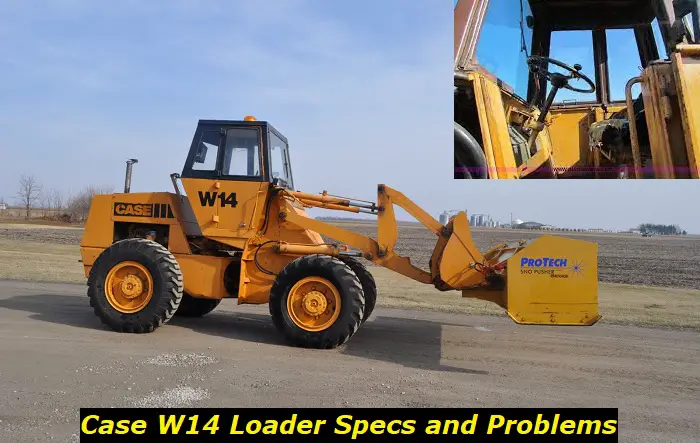Case W14 Loader: Problems, Durability, and Specs
The Case W14 wheel loader is one of the famed Case W Series compact loaders manufactured by CASE Construction Equipment Company. Case machines come with some of the best engines, emissions control, and power output parameters that deliver the performance any operator can dream of.
The Case W series rolled off the factory in the late 1950s and continued through the later years. The Case W Series operator cabs were mounted on the front section of the loader, giving the operator a vantage view in all directions.

In this article, we shall review the Case W14 wheel loader where we look at its specs, durability, and common problems.
Case W14 Specs
The Case W14 wheel loader utilizes a performance technology that enables the machine to deliver extensive on-site experiences. The loaders provide power and torque to match different work cycles that result in high levels of production. They also come with powerful hydraulics systems that make operators enjoy working with them. Generally, the Case W14 wheel loaders come with:
- Powerful breakout force
- Cabs with high operator comfort
- Operator ergonomics
- Low emissions with no particulate filters
- High fuel economy
- Friction-less differential
Size/dimensions
- Length - the base/standard length is 19 ft and six inches without the attachments. This length can be varied based on the type of attachment added
- Height - the base height of Case W14 is 10 ft to the top of the cab with standard wheels and without any attachments.
- Width - the loader is 7 feet and five inches wide without any attachments
- Weight - the Case W14 loader has a standard weight of 18, 193 pounds.
Engine and Specs
- Weight: 14. 665 T
- Engine Power: 62 KW (93HP)
- RPM (Rated): 2200
- Cylinders: 4
- Torque: 320 Nm
- Tires: Standard 15.5x25, 10
- Cylinder Bore: 117 MM
- Cylinder Stroke: 127 MM
- Displacement: 5.11
- Coolant: Fluid
- Coolant Capacity: 26.5 L (5.6 gallons)
- Speed: 40 Km/h (24.8 m/hr)
- Transport Height: 3000 MM (9,84 feet)
- Transport width: 2080 MM (6.8 feet)
- Transport Length: 6120 MM (20 feet)
- Bucket Capacity (Max): 1.53M3
- Bucket Capacity (Min): 1.53M3
Problems
1) Hydraulic issues
The hydraulic system is a critical component in every loader's daily operations. The hydraulic system may suffer from various issues ranging from low pressure to total failure. The most common issues affecting Case W14 wheel loader hydraulics systems include:
- Leakage- Leakages in the hydraulic system lead to reduced pressure and low hydraulic fluid levels. Leakages can be brought by faulty valves or broken seals
- Worn valves- Valves are important components that control the flow of fluid in the system. When they become worn, they cannot control the fluid as expected, thus compromising the functionality of the system.
- Worn pistons-The piston that runs the swash plates in the hydraulic pump may become worn. This prevents the pump from pushing enough fluid into the system for it to function properly.
- Low/poor quality hydraulic fluid- The right amount and quality hydraulic fluid must be in the system for it to function properly. Low levels or poor quality fluid prevents the proper functioning of the hydraulic system.
- Faulty relief valve- The relief valve helps to control system pressure in the hydraulics. If it is faulty, pressure regulation is compromised leading to a failure in the system.
- Faulty compensator valve- the compensator valve is responsible for dividing hydraulic fluid flow/ pressure between two different hydraulic functions occurring simultaneously. Due to its strenuous function, it is prone to quick wear or leakage. When it becomes faulty, some functions of the hydraulic system will fail.
- Hydraulic system overheating- Overheatingcan be brought about by low coolant levels, clogged radiators; faulty pumps/fan belts, or sometimes overworking. An overheating engine will not work properly and may even stall, or lead to more serious and expensive engine damage.
2) Brakes
Case W14 wheel loaders tend to have brake discs wearing out pretty quickly. When the rear brake discs wear out, there is a risk of the brake piston seals leaking, allowing hydraulic oil/brake fluid to leak into the rear axle. This causes issues with the axles which may have their performances compromised.
The Case W14 is a wheel loader and the proper functioning of the axles and the wheels is important for its overall stability and performance.
3) Engine issues
Various common engine issues affect the Case W14 wheel loader.
Engine failing to start. A drained battery, cold, clogged fuel lines/filters, clogged injectors/nozzles, or a faulty starter can all cause the engine not to start. Many reasons can cause the above-mentioned areas to fail, the key among them being lack of proper maintenance. Most of the mentioned areas require regular maintenance checks considering the environments in which loaders operate.
Dust, debris, dirty water, dirty fuel, or rust can all lead to failure of these components which in turn prevent the case W14 engine from cranking into life.
Low throttle or low power output. The Case W14 engine can lose power due to the following issues:
- Clogged/dirty air filter that reduces airflow into the combustion cylinders
- Defective injector nozzles reduce the amount of pressurized diesel injected into the combustion cylinders.
- Dirty/clogged fuel lines which reduce diesel flow into the engine
- Faulty fuel pump which fails to pump fuel to the engine.
- Damaged piston rings allow air-fuel mixture leakage leading to loss of compression
- Improper valve timing/reduces the efficiency of the air intake and exhaust removal from the cylinder, thus losing compression.
- Worn/leaking cylinder head gasket allows loss of compression or leakage of oil into the cylinder head, compromising the combustion process.
Overheating. Overheating can be caused by a lack of a coolant, low engine oil levels, a clogged radiator, or a broken fan belt. Overheating will greatly compromise engine performance and may cause other serious engine damages such as blown head gaskets, seizing, or blown cylinder heads.
Engine stalling after starting. This could be brought about by:
- Faulty fuel pump faulty fuel pump will not deliver fuel to the pump at the right pressure and condition for the engine to run smoothly.
- Low fuel in the tank-the pump is unable to suck the fuel effectively
- Clogged fuel lines prevent fuel from reaching the engine in the right quantity
- Clogged injectors and nozzles prevent proper injection of fuel into the cylinders.
- A faulty combustion process that reduces engine compression
All these issues inhibit the air-fuel mixture ratio which suppresses the combustion process leading to a low compression. The low compression is not enough to maintain the engine, hence, the engine stalls soon after starting, or it runs with a jumpy, jerky movement.
4) Drivetrain issues
The drivetrain is the link between the engine and the wheels as well as all the hydraulics systems associated with the loader. Thus, the powertrain moves the loader while at the same time providing the power required to operate its hydraulic systems.
Drive train problems can be caused by:
- Low hydraulic levels reduce the hydraulic pressure that is required to drive some specific sections of the wheel loader such as the various attachments.
- Defective drive chain-the drive chain transmits power between the engine and the hydraulics drive shaft. If the drive chain is defective, there will be no power transmission for the hydraulics to work
- Faulty drive shaft- the drive shaft transfers torque from the engine to the hydraulic system. The shaft/propeller uses a gear system that may become worn over time, thus interfering with power transmission between the engine and the hydraulics
- Defective foot/hand controls- hand/foot controls are the critical inputs for the entire drivetrain system. Any fault in them means the input signals for the engine and the hydraulic system will not be received.
- Damaged drive pump motor-the drive pump motor works alongside the drive shaft and the drive chain. If the pump is faulty, then the hydraulic system will not get power from the engine.
- Faulty relief valve-relief valves are used to regulate hydraulic pressure by releasing any excess that builds up in the system. If it becomes faulty and fails to relieve (release) the pressure, the drivetrain and the hydraulics will not function properly.
- Damaged throttle cable-the throttle cable must be securely attached to control the engine throttle properly. If faulty, the entire drivetrain will suffer since the engine will not have the required throttle to maintain power output.
5) Lift arm problems
The lift arm may fail to lift or to lower when commanded to do so. This can be a problem brought about by:
- Faulty lift controls in the loader
- A faulty hydraulic pump which does not provide enough power to lift or lower
- Damaged hydraulic valves- these allow hydraulic leakages which reduce pressure in the system
- Insufficient hydraulic fluid compromises the amount of pressure required for lifting or lowering.
6) Bucket Issues
The bucket may fail to move or tilt due to
- Faulty bucket controls
- Defects in the hydraulic system
- Damaged bucket cylinder
- Low hydraulic fluid in the system
The mentioned issues will curtail the operations of the loader bucket and prevent it from working properly.
Durability
The Case W14 wheel loader, like most of its counterparts in this segment, is a reliable tractor that was built to last. Regardless of the work sites, Case W14 will give the owner quite a long uninterrupted service provided proper maintenance routine is adhered to.

Add comment